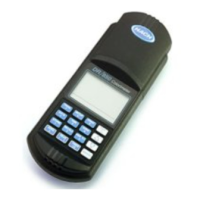375
The PhosVer 3 Phosphate Reagent Powder Pillows should be
stored in a cool, dry environment.
Method Performance
Precision
In a single laboratory, using a standard solution of 3.00 mg/L
PO
4
3-
and two lots of reagent with the instrument, a single
operator obtained a standard deviation of ±0.06 mg/L PO
4
3-
.
Estimated Detection Limit
The estimated detection limit for program 82 is 0.07 mg/L PO
4
3-
.
For more information on the estimated detection limit, see
Section 1.
Sample Disposal Information
Final samples will contain molybdenum. In addition, final
samples will have a pH less than 2 and are considered corrosive
(D002) by the Federal RCRA.
Summary of Method
Phosphates present in organic and condensed inorganic forms
(meta-, pyro- or other polyphosphates) must be converted to
reactive orthophosphate before analysis. Pretreatment of the
sample with acid and heat provides the conditions for hydrolysis
of the condensed inorganic forms. Organic phosphates are
converted to orthophosphate by heating with acid and persulfate.
Orthophosphate reacts with molybdate in an acid medium to
produce a phosphomolybdate complex. Ascorbic acid then
reduces the complex, giving an intense molybdenum blue color.
Turbidity (large amounts) May cause inconsistent results because the acid present in
the powder pillows may dissolve some of the suspended
particles and because of variable desorption of
orthophosphate from the particles.
Zinc 80 mg/L
Highly buffered samples or
extreme sample pH
May exceed the buffering capacity of the reagents and
require sample pretreatment; see pH
Interferences (Section 1).
PHOSPHORUS, ACID HYDROLYZABLE, continued

